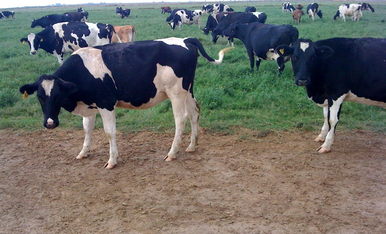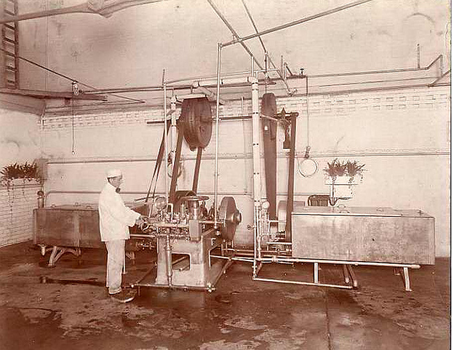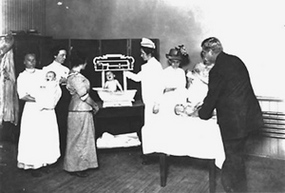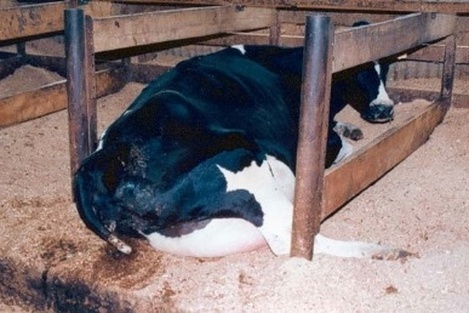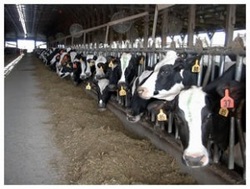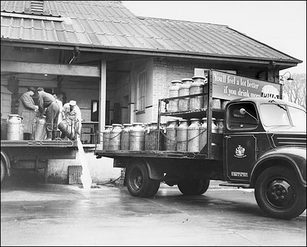Introduction
Many Americans don’t take their health seriously. The rising obesity rate is proof of that. For an understanding of obesity’s progression in the United States from 1985 to 2011, watch the YouTube video below.
Despite the catchy jingle in the background, there is an ominous overture to the facts of this video. However, there is still hope for Americans’ health. Movies such as Super Size Me and Food Inc. are bringing awareness to the public, as advocate groups such as PETA and New Jersey’s own Garden State Raw Milk. With so many people voicing “facts” and opinions, it can be rather overwhelming. So, we will focus on one specific item: milk. This research project will bring to light the truth of pasteurized milk and the controversial raw milk many have turned to.
Research Process
At the start of the project, we knew nothing about raw milk. We couldn’t have even defined it for you. However, the topic came to mind after watching Food Inc. A friend of Erica's once mentioned her family drinking raw milk as an alternative to that you can buy in the store. After voicing the idea, we ran with it, directly to that friend.
In an interview with her mom, Sherry Clarence, we collected general information about the topic: the types of milk, the dangers of pasteurized milk, the benefits of raw milk, and personal experiences. Most beneficial however, was the connection this interview allowed us to make with one of the founders of Garden State Raw Milk, registered dietitian Pam Schoenfeld. In interviewing Pam, we collected both the science behind raw milk and the legal standing of raw milk.
Despite the amount of knowledge obtained from these interviews on behalf of raw milk, there was still investigating to be done. This time, we took information from books and online sources. Mainly, we wanted to present to our audience an unbiased paper in which they could make their own informed decision about milk.
Types of Milk
When talking about milk, there’s three types to consider: raw, thermalised, and pasteurized.
Research Process
At the start of the project, we knew nothing about raw milk. We couldn’t have even defined it for you. However, the topic came to mind after watching Food Inc. A friend of Erica's once mentioned her family drinking raw milk as an alternative to that you can buy in the store. After voicing the idea, we ran with it, directly to that friend.
In an interview with her mom, Sherry Clarence, we collected general information about the topic: the types of milk, the dangers of pasteurized milk, the benefits of raw milk, and personal experiences. Most beneficial however, was the connection this interview allowed us to make with one of the founders of Garden State Raw Milk, registered dietitian Pam Schoenfeld. In interviewing Pam, we collected both the science behind raw milk and the legal standing of raw milk.
Despite the amount of knowledge obtained from these interviews on behalf of raw milk, there was still investigating to be done. This time, we took information from books and online sources. Mainly, we wanted to present to our audience an unbiased paper in which they could make their own informed decision about milk.
Types of Milk
When talking about milk, there’s three types to consider: raw, thermalised, and pasteurized.
Raw Milk
Raw milk is technically milk taken straight from the cow. However, it is important to note that raw milk intended to be consumed raw and that on its way to being pasteurized have very different standards of care and handling. The raw milk intended to be consumed raw abides certain hygienic guidelines as well as screenings for potential contamination (Clarence).
Raw milk is technically milk taken straight from the cow. However, it is important to note that raw milk intended to be consumed raw and that on its way to being pasteurized have very different standards of care and handling. The raw milk intended to be consumed raw abides certain hygienic guidelines as well as screenings for potential contamination (Clarence).
Cows which produce raw milk intended to be consumed raw are fed only organic fresh foods. Those whose milk will be pasteurized are fed starchy foods which affect the acids in their stomach, leading to illnesses and a shortened lifespan on the cows end (Clarence).
Where raw milk is legal, people can get it on the farm, or in some cases, from the store. Because of a black mark left by raw milk from the 1800s though, it is illegal in several states (Clarence). In these states, those like Clarence and her family will drive from New Jersey to Pennsylvania for it or Pamela Schoenfeld who has set up a delivery system with friends and family.
Some however, have found even loopier holes to crawl through. Raw milk is only illegal in states for the sale of the product to humans. In the production of animal food, it is perfectly legal. As a result, many companies have been created to produce raw milk and dairy products for pets. Whether they mean for people to consume these products or not does not matter; people do (Sundstrum).
Where raw milk is legal, people can get it on the farm, or in some cases, from the store. Because of a black mark left by raw milk from the 1800s though, it is illegal in several states (Clarence). In these states, those like Clarence and her family will drive from New Jersey to Pennsylvania for it or Pamela Schoenfeld who has set up a delivery system with friends and family.
Some however, have found even loopier holes to crawl through. Raw milk is only illegal in states for the sale of the product to humans. In the production of animal food, it is perfectly legal. As a result, many companies have been created to produce raw milk and dairy products for pets. Whether they mean for people to consume these products or not does not matter; people do (Sundstrum).
Thermalised Milk
The second type of milk, thermalised milk, is milk that has been heated to 140 to 150 degrees for 15 to 30 seconds. While the United States claims that is raw milk, the European union considers it pasteurized milk (Clarence). Because the milk is only partially heated to the health standards of pasteurized milk, it leaves form for bacteria growth. This heating process however, multiples the bacteria and encourages it to grow, unlike raw milk (Brief).
“I don’t think it’s right,” said Clarence, “that any illnesses that would occur from a thermalised product, a lot of the times, are tossed into the raw milk column [. . .] they don’t belong there.”
The second type of milk, thermalised milk, is milk that has been heated to 140 to 150 degrees for 15 to 30 seconds. While the United States claims that is raw milk, the European union considers it pasteurized milk (Clarence). Because the milk is only partially heated to the health standards of pasteurized milk, it leaves form for bacteria growth. This heating process however, multiples the bacteria and encourages it to grow, unlike raw milk (Brief).
“I don’t think it’s right,” said Clarence, “that any illnesses that would occur from a thermalised product, a lot of the times, are tossed into the raw milk column [. . .] they don’t belong there.”
Pasteurized Milk
Pasteurized milk is defined as milk that has been heat-treated to kill pathogens that cause disease. If the milk does get pasteurized then all the diseases that could happen are theoretically prevented. Named after Louis Pasteur, the pasteurization process was created in 1862 (Brief). According to S. E. Smith in “What is Pasteurized Milk?,” “He performed early pasteurization tests, determined render milk safe to drink, and the practice was adopted very quickly.”
Pasteurized milk is defined as milk that has been heat-treated to kill pathogens that cause disease. If the milk does get pasteurized then all the diseases that could happen are theoretically prevented. Named after Louis Pasteur, the pasteurization process was created in 1862 (Brief). According to S. E. Smith in “What is Pasteurized Milk?,” “He performed early pasteurization tests, determined render milk safe to drink, and the practice was adopted very quickly.”
However, pasteurization no longer has one definition. Instead, it has come to mean different things as a result of different pasteurization procedures. The first form of pasteurization is called high temperature/short time [HTST] pasteurization. In this process, the milk is heated to 161 degrees Fahrenheit for 15 to 30 seconds (Smith).
A second type of pasteurized milk is called extended shelf life [ESL] milk. This milk is heated at a lower temperature than HTST and then put through a filter to remove any left over bacteria. Opposite of this, is ultra high temperature [UHT] pasteurization in which milk is heated to 250 degrees Fahrenheit no longer than a second. No matter the pasteurization process, the milk is then cooled and kept in cold storage (Smith).
According to Cindy Brock in “Furthering Families-Milk Pasteurization-Pasteurization and Handling Requirements,” certain standards in handling the milk must be met. A potable water supply and proper dispensing system must be available to avoid contamination. This potable water provides a hot and cold water for cleaning the animals as well as the utensils and worker’s hands. To uphold these standard, producers must meet regular inspections (Brock).
A second type of pasteurized milk is called extended shelf life [ESL] milk. This milk is heated at a lower temperature than HTST and then put through a filter to remove any left over bacteria. Opposite of this, is ultra high temperature [UHT] pasteurization in which milk is heated to 250 degrees Fahrenheit no longer than a second. No matter the pasteurization process, the milk is then cooled and kept in cold storage (Smith).
According to Cindy Brock in “Furthering Families-Milk Pasteurization-Pasteurization and Handling Requirements,” certain standards in handling the milk must be met. A potable water supply and proper dispensing system must be available to avoid contamination. This potable water provides a hot and cold water for cleaning the animals as well as the utensils and worker’s hands. To uphold these standard, producers must meet regular inspections (Brock).
The History of Raw Milk
Cultures have been drinking animal’s milk for thousands of years, whether it’s from a goat, sheep, or a variety of other animals. The most common animal associated with producing milk for humans however, is the cow. Cow’s milk provides necessary vitamins and nutrients as well as a rich taste (Schoenfeld).
As the demand for city life grew, so did demand for milk and whiskey. When the war of 1812 broke out, our supply of whiskey dried up. To meet demands, distilleries came to the city. To gain more profit, many of these distilleries also began producing milk (Brief).
After creating alcohol, a product called spent grain is left over. This concoction is the processed grain that has turned to a malt and grain residue. The distilleries would then feed this grain to the cows put in the distillery basement. Because of the dark and damp location, both the cows and the workers milking them would easily get sick. As a result of the “industrial waste” fed to the cows, the horrible living conditions they lived in, and thus the working conditions, the milk itself became toxic. Nonetheless, it was sold and drank by humans (Clarence).
“People look back on that,” said Clarence, “and remember aunt Martha and six of her eight children dying from bad milk. Well, that could very well be true, but that’s not the raw milk [today].”
Children were in fact the most affected by this milk (Brief).
“A pale, bluish milk so poor in quality,” according to ‘A Brief History of Raw Milk,’ “it couldn't even be used for making butter or cheese … was fed to babies by their unwitting mothers.”
After creating alcohol, a product called spent grain is left over. This concoction is the processed grain that has turned to a malt and grain residue. The distilleries would then feed this grain to the cows put in the distillery basement. Because of the dark and damp location, both the cows and the workers milking them would easily get sick. As a result of the “industrial waste” fed to the cows, the horrible living conditions they lived in, and thus the working conditions, the milk itself became toxic. Nonetheless, it was sold and drank by humans (Clarence).
“People look back on that,” said Clarence, “and remember aunt Martha and six of her eight children dying from bad milk. Well, that could very well be true, but that’s not the raw milk [today].”
Children were in fact the most affected by this milk (Brief).
“A pale, bluish milk so poor in quality,” according to ‘A Brief History of Raw Milk,’ “it couldn't even be used for making butter or cheese … was fed to babies by their unwitting mothers.”
This resulted in infant mortality floating around 20% for several years during the 1870s. New Jersey doctor Henry Coit, who would loose his own sun a few years after, created the Medical Milk Commission which regulated milk production. Raw milk had once again become safe, continuing to be regulated in state’s that allow the sale of it to be legal (A Brief History).
Nonetheless, some believed the only safe milk was pasteurized milk. Because of the black mark left on raw milk by the distilleries and campaigns ignoring Coit’s victory, state’s began to make the sale of raw milk illegal in 1944 (Brief). Though the majority once had raw milk as an illegal item for sale, it is now illegal in only twenty-seven states as a result of public advocacy (Clarence).
Two Sides to a Cow: For Raw Milk
“It’s not homogenized so the fats aren’t all screwed up. The proteins are more digestible, less allergenic. The vitamins are generally better maintained because the heat often destroys a number of vitamins. If the car are out on pasture they’re likely to have more vitamin A and vitamin D in the milk.” (Schoenfeld)
A lot more people believe raw milk is more bioavailable: builds stronger bones, better facial features. People who are considered lactose and tolerant don’t have the enzyme to break down the milk sugar, but the lactic acid bacteria in the milk produce lactate and the can break down the lactose. so a lot of people who have problems drinking pasteurized milk can drink raw milk. (Clarence)
Within the last fifteen years, there have been zero raw milk related deaths out of the nine million people believed to be drinking raw milk. However, the last milk related death occurred in 2007 as a result of pasteurized milk (Clarence).
“[My oldest daughter] was really quite sickly as a child,” said Clarence, “lots of ear infections, on antibiotics for months on end. She and our next daughter had a lot of illness . . . both had surgery at a pretty young age. By the time the next two came along we made some changes in our diets, but had not started on raw milk. Now, by the time our youngest three came along, in 42 child years, cause they’re 15, 15 and 12, they have had no infections and each of the three youngest have only ever had one round of antibiotics in their entire life,” (Clarence).
Besides the condition of the milk being of better quality, the conditions in which the milk is produced are also better. Cows for the purpose of producing raw milk live on the land, grazing beneath the sun amongst other cows (Clarence). If that is heaven, then cows meant for producing pasteurized milk live in hell. They live in a warehouse among as many as 10,000 other cows (Schoenfeld). These cows are chained to posts so they cannot move around freely, never seeing the light of day. The lack of exercise results in them becoming frail and sickly (Clarence).
Growth hormones meant to increase the cows' utter size, for larger milk production, result in an excessive amount of weight on the cows weak legs. As a result, they continuously collapse until they're down for good. The dairy industry will then cut their losses by sending the cow to the slaughter house. On average, a cow will live 25 years, but in these warehouses, they will be slaughtered within three to four years (Food Inc.).
“Traditionally,” said Schoenfeld, “what a cow is for, is to go out and graze, not to be fed grain. That’s actually a relatively new phenomenon because that’s a more inexpensive way to feed a cow, but usually you’ll get more milk out of that cow by feeding it grain. That’s the way manufacturers, or, I’m sorry, dairy producers can produce more milk.”
Since cows are not built to eat and digest corn, soy, and other such supplements pasteurized milk producing cows are fed, several ailing effects arise (Clarence). The cows get fatter quicker, quicker than their bodies can handle (Schoenfeld). Not able to support themselves, it is another reason their legs give out. Also, this diet has a lasting effect on the nutrients and vitamins in their diet. Since these vitamins and nutrients are missing form their diet, such vitamins and nutrients are ultimately missing from ours (Food Inc.).
Since cows are not built to eat and digest corn, soy, and other such supplements pasteurized milk producing cows are fed, several ailing effects arise (Clarence). The cows get fatter quicker, quicker than their bodies can handle (Schoenfeld). Not able to support themselves, it is another reason their legs give out. Also, this diet has a lasting effect on the nutrients and vitamins in their diet. Since these vitamins and nutrients are missing form their diet, such vitamins and nutrients are ultimately missing from ours (Food Inc.).
Conditions of the milk itself and the cows aside, the economy would also prosper for states that allow the legalization of raw milk. In testimony, farmers have said that they receive only 75 cents per gallon when outsourcing their milk for sales. Were they allowed to sell it themselves, farmers could retain one hundred percent of the profit (Clarence).
“A family our size,” says Clarence, “we drink on average four gallons a week, at five dollars a gallon. We’re talking 20 dollars a week; that’s a thousand dollars a year that could stay in our area just on milk.”
However, that example only includes milk. The bill that’s been proposed in New Jersey would not only legalize the sale of milk, but also that of milk bi-products such as cheese, yogurt, cream, and more (Schoenfeld). As a result, the monopoly on milk would one day come to an end so farmers and consumers could share in the financial and nutritional wealth.
However, that example only includes milk. The bill that’s been proposed in New Jersey would not only legalize the sale of milk, but also that of milk bi-products such as cheese, yogurt, cream, and more (Schoenfeld). As a result, the monopoly on milk would one day come to an end so farmers and consumers could share in the financial and nutritional wealth.
Two Sides to a Cow Continues: Against Raw Milk
Edward Zimney, in “Raw Milk: Helpful or Hurtful”, said, “Since 1987, it has been illegal to sell milk that has not been pasteurized via interstate commerce. Since this is a federal law and deals only with interstate commerce, raw unpasteurized milk is legally available in at least 27 states plus a few others where creative methods are used to exploit loopholes.”
Accredited agencies such as the FDA and CDC warn consumers that drinking raw milk is dangerous to your health. It can result in illness, but also death. Such results occur because of how easily raw milk can be contaminated. This contamination mainly occurs because of the cow’s manure. Without the pasteurization process, the bacteria found in the manure spreads to and infects the milk (Zimney).
Health reports taken from 1998 to May 2005 show that raw milk and raw milk products were the cause of 45 food born illnesses in the United States. Such diseases included salmonella, listeria, campylobacter, yersinia, E. coli, and staphylococcus (Hannon).
Doug Gieryn of the Wisconsin Public Health Association says, “tests can’t catch all the potential pathogens that could be present in the product, and sales could put the health of the public at risk,” (Opposition).
Though such views have made raw milk illegal in some states, such as New Jersey, raw milk advocates and legislators are attempting to make the sale of it legal in other states (Schoenfeld). Brian Baker of The Wisconsin Cheese Makers Association fears this could immensely damage their dairy industry as a result of diseases spread by unpasteurized milk (Opposition).
John Sheehan, director of the food and drug administration in the division of dairy and egg safety, said, “It’s like playing Russian Roulette with your health [. . .] there is absolutely no health benefits from consuming raw milk,” (Hannon).
Health reports taken from 1998 to May 2005 show that raw milk and raw milk products were the cause of 45 food born illnesses in the United States. Such diseases included salmonella, listeria, campylobacter, yersinia, E. coli, and staphylococcus (Hannon).
Doug Gieryn of the Wisconsin Public Health Association says, “tests can’t catch all the potential pathogens that could be present in the product, and sales could put the health of the public at risk,” (Opposition).
Though such views have made raw milk illegal in some states, such as New Jersey, raw milk advocates and legislators are attempting to make the sale of it legal in other states (Schoenfeld). Brian Baker of The Wisconsin Cheese Makers Association fears this could immensely damage their dairy industry as a result of diseases spread by unpasteurized milk (Opposition).
John Sheehan, director of the food and drug administration in the division of dairy and egg safety, said, “It’s like playing Russian Roulette with your health [. . .] there is absolutely no health benefits from consuming raw milk,” (Hannon).
Summary/Closing
Despite research supporting both raw and pasteurized milk, the amount of research we acquired shows that raw milk is the most beneficial of the two. In summary, raw milk contains more nutriants needed in a person's diet, provides better care of the animals, and benefits local economies. Pasteurized milk may remove the bad bacteria that causes diseases associated with milk, but has also robbed it of the good bacteria. The conditions of the cows and workers in association with pasteurized milk though, is all fact and none of the controversy. In presenting these facts and opinions, we hope to have informed you enough to make an educated decision about how to live a healthier life one glass of milk at a time.
*Note - to see whether raw milk is legal in your state visit this website, go to your state, click statutes, and in the search on the right side, type milk into the keyword section. Unless of course you know the bill number off the top of your head. In which case, you probably don’t need the search.
